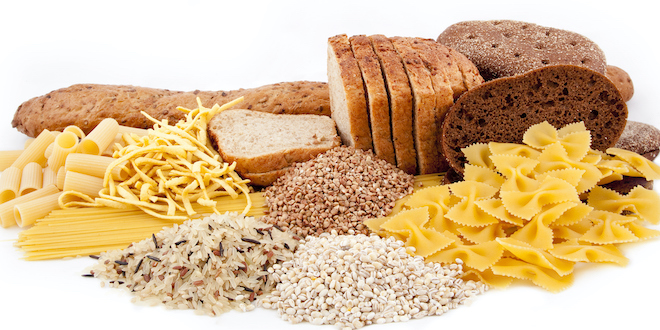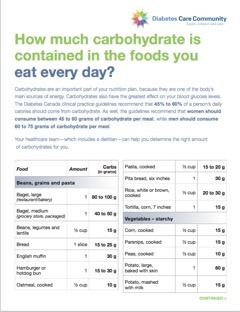Carbohydrates are an important part of your nutrition plan, because they are one of the body’s main sources of energy. Carbohydrates also have the greatest effect on your blood glucose levels. That’s why knowing how much carbohydrate you are consuming can help you keep your blood sugar levels in their target ranges.
How many carbs per day are recommended for people with diabetes?
The Diabetes Canada clinical practice guidelines recommend that 45% to 60% of a person’s daily calories should come from carbohydrate. As well, the guidelines recommend that women should consume between 45 and 60 grams of carbohydrate per meal, while men should consume 60 to 75 grams of carbohydrate per meal. Your healthcare team – which includes a dietitian – can help you determine the right amount of carbohydrates for you.
To determine the impact of carbohydrate on your blood sugar levels, it is a good idea to test your blood sugar just before you eat, and then two hours after a meal. You can then see how carbohydrate raises your blood glucose level, and by how much.
So, what foods contain carbohydrate – and how much?
We’ll review the carbohydrate content of various foods groups in this article. (Check the Nutrition Facts Table on packaged foods for the exact amount of the carbohydrate content of the foods you’re consuming.)
|
Food |
Amount |
Carbohydrate |
|---|---|---|
|
Beans, grains and pasta |
||
|
Bagel, large (restaurant/bakery) |
1 |
80 to 100 grams |
|
Bagel, medium (grocery store, packaged) |
1 |
40 to 50 grams |
|
Beans, legumes and lentils |
½ cup |
15 grams |
|
Bread |
1 slice |
15 to 25 grams |
|
English muffin |
1 |
30 grams |
|
Hamburger or hotdog bun |
1 |
15 to 30 grams |
|
Oatmeal, cooked |
½ cup |
10 grams |
|
Pasta, cooked |
½ cup |
15 to 20 grams |
|
Pita bread, six inches |
1 |
30 grams |
|
Rice, white or brown, cooked |
½ cup |
20 to 30 grams |
|
Tortilla, corn, 7 inches |
1 |
15 grams |
|
Vegetables – starchy |
||
|
Corn, cooked |
½ cup |
15 grams |
|
Parsnips, cooked |
½ cup |
15 grams |
|
Peas, cooked |
½ cup |
10 grams |
|
Potato, large, baked with skin |
1 |
60 grams |
|
Potato, mashed with milk |
½ cup |
15 grams |
|
Squash |
1 cup |
20 grams |
|
Sweet potatoes and yams |
1 medium |
20 grams |
|
Dairy products |
||
|
Milk |
1 cup |
12 grams |
|
Rice milk, plain |
1 cup |
23 grams |
|
Soy milk, plain |
1 cup |
8 grams |
|
Yogurt, flavoured, artificially sweetened |
100 grams or ⅓ cup |
6 grams |
|
Yogurt, flavoured |
100 grams or ⅓ cup |
15 grams |
|
Yogurt, plain |
100 grams or ⅓ cup |
6 grams |
|
Fruits | ||
|
Apple, small |
1 |
15 grams |
|
Banana, six inches |
1 |
20 grams |
|
Blackberries |
1 cup |
7 grams |
|
Blueberries |
1 cup |
15 grams |
|
Cherries |
12 |
15 grams |
|
Grapefruit, large |
½ |
15 grams |
|
Grapes |
15 |
15 grams |
|
Nectarine, medium |
1 |
15 grams |
|
Orange, medium |
1 |
15 grams |
|
Raspberries |
2 cups |
15 grams |
|
Strawberries, halved |
2 cups |
15 grams |
|
Watermelon, diced |
1 cup |
10 grams |
|
Condiments | ||
|
Honey |
1 tablespoon |
15 grams |
|
Jam and jelly |
1 tablespoon |
15 grams |
|
Ketchup |
¼ cup |
15 grams |
|
Sugar |
1 tablespoon |
12 grams |
|
Snacks and baked goods |
||
|
Donut, plain |
1 |
25 grams |
|
Melba toast |
4 |
15 grams |
|
Popcorn, popped |
3 cups |
15 grams |
|
Potato chips |
10 to 15 |
15 grams |
|
Pretzels, small |
33 |
15 grams |
|
Saltine crackers |
7 |
15 grams |
|
Tortilla chips |
10 to 15 |
20 grams |
Is carb content important for people with type 2 diabetes?
Everyone needs carbs as they provide the main energy source. But it's important to choose the right ones. Knowing the amount and type of carbohydrates you consume can help you learn how to manage your blood glucose levels more effectively.
People have successfully followed low carb diets to lose weight and manage their diabetes including lowering their A1C, cholesterol and blood pressure levels as well as reducing the amount of diabetes medications they take. Research has shown that these diets are generally effective in the first 6 months for weight loss, but they are difficult to maintain for the longterm. If you are restricting your carb intake and are taking diabetes medications that put you at risk of hypos, check your blood glucose levels regularly and speak to your healthcare team to review your medications.
In general, it is better to aim for an overall healthy eating pattern rather than to restrict one component of the diet. A healthy diet includes higher amounts of whole fruits and vegetables, whole grains, healthy fats (vegetable oils), and healthy proteins (nuts, legumes, eggs, seafood, and poultry) and limits bad carbs (such as refined grains and added sugars), red and processed meat, sodium, saturated fats, and trans fats.
 Diabetes Care Community Learn, connect and care
Diabetes Care Community Learn, connect and care







One comment
Pingback: Top 10 tips to reverse diabetes - Diabetes Care Community